In my last post, I drew some parallels between Rothbury and Bonnaroo. That was fun, but let's get to the point--what did Sarah and the gang actually do to make this festival so green? Follow me on a behind the scenes tour through the festival as we dig deep and dig dirty into the nuts and bolts of setting up a temporary city in a green fashion.
Rothbury's attendance came out at somewhere around 35,000-40,000, roughly the same size as Burlington, VT, so it's not a stretch when I say that this really is a temporary city. And just like any other city, festival organizers have to deal with real city issues: waste management, providing clean drinking water and decent sanitation services, community relations with neighboring municipalities, transportation issues, and so on. At Rothbury, they also took on the decidedly city-like tasks of education and public art. We'll cover each of these issues one-by-one in this post. Ready? Let's go!
Transportation: Getting There
One of the problems of a camping festival is that it's pretty hard to find a site that's easily accessible on any kind of decent public transportation. By and large, people drive to these things, with the exception of us uber-polluters who really burn some carbon and fly there. I flew in, feeling vaguely guilty about my vastly inflated carbon footprint, but at least I was able to catch the shuttle offered by Mr. Busdriver and come in car-free.
Mr. Busdriver is a relatively new service, run by a frenetic but cheerful madman named Rick. He's going after the festival market in a big way by organizing bus transportation to and from these festivals. I got to meet him at the festival and he's an all around good guy, but he seemed frighteningly disorganized at times. I think all 7 of us on the special van he chartered to pick up the stragglers at the airport got 4 or 5 phone calls and emails from him in the days before the festival and on our arrival day itself. But he managed to keep it all together and after a 90-minute wait at the airport we got in our van. The driver he hired was good enough to stop at a local grocery store so we could buy some essentials before we got sequestered into the land of expensive festival general stores, so I was able to load up on PBR and cheap gin. In comparison to the nightmarish ride I had in to Langerado, this was pure luxury. I just hope that next time around, he's a little bit more organized.
Our ride in was fast and traffic-free, and as promised we ended up at a special back entrance close to the main gate. Things briefly fell apart there, though. By now it was 9:30, a full 4.5 hours after I'd arrived at the airport 75 miles away, and all of us were anxious to get into the festival. But for some reason, security wouldn't let us in, so we had to cool our heels in the parking lot of a nearby school while Rick frantically negotiated with the guards. Eventually, a compromise was reached, and we were allowed to walk through the gates. This meant unloading all of our bags and groceries, walking through security, and loading our gear back up into a separate van on the other side of the gates for a brief ride to car-free camping.
Once there, we were informed that we would need to be on a 7AM shuttle bus on the way out Monday morning, even though most of us had afternoon flights. Apparently, the 10AM bus had sold out, but at this point we all just wanted to get in. Car-free camping turned out to be great, a beautiful lawn just a 3-minute walk from the main gate and near the general store and merch tents, with a lightly-used (hence always clean) bank of well-lit portapotties right next to us and showers and water station a few minutes beyond.
It's worth mentioning that the organizers planted grass on hundreds of acres of camping areas and on the festival grounds themselves to make things more comfortable for us, and it's a good thing, too. Before we arrived, there were several inches of rain, but there were only a couple of muddy spots. Compared to Phish's IT and Coventry festivals and Bonnaroo 2004, all muddy disasters, this was a fantastic experience.
Of the people I talked to who drove in, not one had any complaints of significant traffic jams on the way in. That's not just a fan-pleaser, but an environmentally good thing. Having thousands of fans sit in traffic for 6 or more hours, as seems to be the case at most festivals, is a huge waste of fuel and a terrible thing for local air quality, never mind the CO2.
Speaking of CO2, the festival offered fans the chance to offset their CO2 in transit for a paltry $3 via the Bonneville Environmental Foundation, with an upgrade to a $7 package that also supported a very large solar project on the school where we cooled our heels. A nice touch was that we could buy these offsets on site if we didn't do it when we purchased tickets. Since my ticket was comped by the festival, this gave me a way to offset my own travel. Organizers reported that about 20% of the fans chose to offset, a huge number in the world of offsets, and the vast majority of those contributed to the school's solar panels.
So what went right and what went wrong with transportation? Well, the lack of traffic jams was a huge plus, although I'm not sure whether to credit this to the size of the crowd or the organizers. The push for offsets and the ease of buying them was also a good thing. Organizers went to great lengths to get people out of their cars and promote carpooling, offering incentives like the fantastic car-free camping and options like Mr. Busdriver. On the down side, the interface between Mr. Busdriver and the festival was poorly done. It's to the festival's benefit to get more people to come in by bus, so they need to better integrate ordering bus tickets into the Rothbury website, work with Rick to set up a schedule of bus service that makes sense and help him fill as many buses as possible, and most importantly make sure that nothing like our horrible welcome by security ever happens again.
The festival also needs to pick one carpooling partner and funnel all the ridesharing to that central location. Pickuppal.com is making a play to be the music-related rideshare organization of choice, but when I spoke with management there, they told me that Rothbury had declined an offer to go exclusive with them because of perceived liability issues. Pickuppal is the official rideshare partner of both Dave Matthews and John Mayer, so it would have made sense to use the service for Rothbury instead of directing us to no fewer than 10 rideshare sites, ensuring that no one site got a critical mass going.
To finish on a more positive note, the festival did a good job of partnering with Amtrak and the local ferry services, and it would be really wonderful to see them expand and better promote these in future years. With some sources predicting $7 a gallon gas by next summer, anything Rothbury can do to help customers get to the site will be sure to pay back with increased attendance.
Waste Management
Rothbury really shined when it came to taking out the trash, mostly by doing everything they could to make sure there wasn't nearly as much trash in the first place. A crew of more than 500 volunteers manned hundreds of waste stations, each with three different-colored bins for compost, recyclables, and landfill.
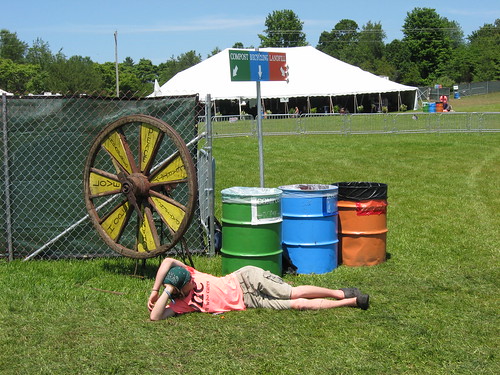
A volunteer hard at work manning the waste stations.
The volunteers were there to make sure that patrons knew which bins to use for things that might not normally be associated with compost. Every vendor was required to purchase compostable cups made from corn, compostable plates made from wheat, and compostable silverware made from rice. All of the beer was either draft or served in aluminum bottles (and by the way, having a couple of non-Bud options was a well-received plus). There were at least 3 or 4 sources of free water in the grounds and patrons were encouraged to bring refillable water bottles. Those of us who chose to purchase $3 bottles of water were served Earth Water, which gives 100% of profits to the UN Refugee Agency to provide clean drinking water to the developing world. And outside of food and beverage items, what is there really to dispose of inside the festival gates?
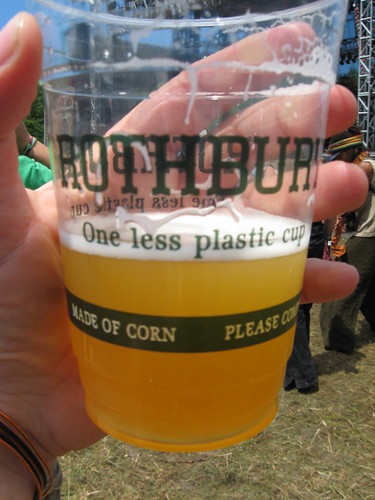
As the picture above indicates, the volunteers manning the bins looked pretty bored most of the time because organizers made sure from the get-go that everyone knew the deal. The back of the folded festival guide/map, which was itself far smaller than the books given out at other festivals and presumably printed on postconsumer recycled paper, was entirely devoted to a simple graph detailing what belonged in each bin, and once people had been gently instructed by the first volunteer what they should do, they pretty much got it.
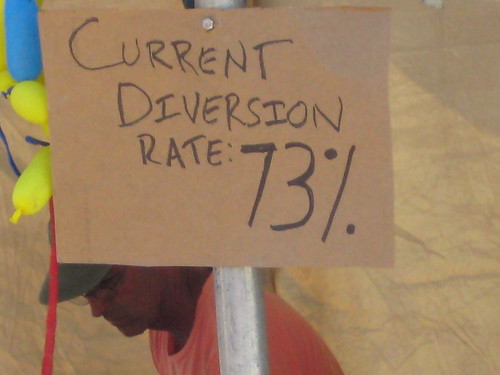
All this attention to managing waste paid off, as Sarah gleefully announced a diversion rate of more than 80% at a press conference dedicated to the green aspects of the festival. When we visited the waste collection area the next day, this was down slightly to 73%. Sarah explained that as they moved between waste collection in the campgrounds and the festival grounds, the figure fluctuated but that they were hoping to end up with over 80% of the waste diverted. Speaking of campground waste, the festival collected all of the discarded tents, coolers, shoes, and anything else of value and donated them to local charities instead of tossing them.
While the volunteers manning the waste stations were happily underworked, the volunteers behind the scenes at the waste station couldn't make any such claims. When a small army of journalists showed up in golf carts to check out composting in action, we found about 10 very industrious volunteers laboriously sorting the contents of every bag of trash, recycling, and compost to make sure that everything ended up in the right pile. The workers seemed to be in high spirits, with Phish blaring from a boombox and once-per-shift cash prizes given to the lucky winner who found the most unusual or humorous piece of refuse. One thing that surprised me was that the compost pile didn't smell nearly as bad as I expected it would, although it certainly wouldn't have passed for perfume. Unfortunately, we were too early to see the giant grinder Sarah had commissioned to mulch the compost arrive to perform its work.

Sarah Haynes in front of the compost pile, holding a bottle of Earth water.

Even the bags that held the compost are biodegradable!
Perhaps the best part about all of this was that the festival grounds were always spotless after fans left. People really seemed to get into the spirit, and there were far fewer discarded water bottles and cups than I've come to expect at the end of most sets. I even had a volunteer walk up to me while I was chatting with one of the festival artists after a set and relieve me of a beer cup I'd been planning to compost later. The crew at Madison House told me that they needed far fewer people to clean up after each set than at other festivals--as few as 7 in one instance, compared to perhaps 150 at a similar event elsewhere. And it showed--in the picture below, you won't see anything at all, not a cup or bottle or even a bottle cap. The organizers even handed out matchbox-sized personal ashtrays, which while certainly not 100% effective might have helped a bit.
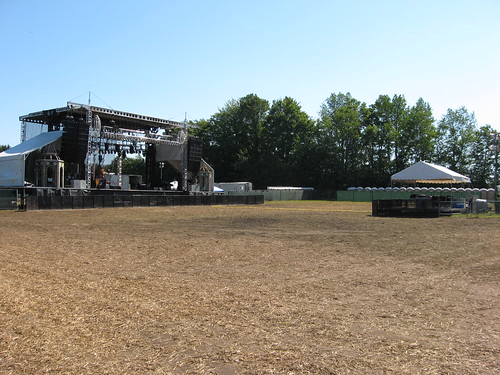
Not a speck of trash!
So what went right and what went wrong? This is an easy one--waste collection and diversion was the festival's most visible and obvious success. The only hiccup I found was that we weren't given either trash bags or recycling bags when we entered the festival, although that might have been related to the whole snafu when we entered the festival.
Water and Sanitation
One of the things that can make or break a festival is adequate drinking water and decent restroom facilities. The water stations at this year's Langerado were abysmal on the one occasion when I could actually find water, and the toilets at the 2004 Bonnaroo were among the most disgusting things I've ever witnessed in a long and depraved career, Fear Factor times 10 (the toilets at last year's Bonnaroo were much improved).
So I was very pleased to see that the water stations in the campgrounds seemed to be well laid out. They used the shipping container approach that Bonnaroo pioneered, with trough sinks and a floor to keep you out of the mud, and all the water going to a big frac tank. Showers, reportedly sometimes hot, could be had for $10 with very short lines, and there were a smattering of free water stations inside the festival gates.
The restrooms, standard plastic portolets, were in general as clean as I've seen them at any festival, although we were a bit spoiled by our underused car-free camping restrooms. Some of the restrooms even had mirrors and a shelf for your beer! I can't recall waiting more than one minute for a restroom at any point during the weekend, and by and large the restrooms were located under a light source, one of those simple but often-overlooked touches that really helps keep the filth quotient down.
All in all, the festival did a nice job with these essentials. What went right? Good water services in the campgrounds, free water refills in the festival, and clean and numerous toilets. I can't say anything went wrong, but I'd really like to see the festival break new ground in the US festival scene and push for some really nice composting toilets. I'd also like to see a sink of some sort outside some of the larger banks of restrooms for handwashing, or at least a tub of antibacterial gel. I'd also like to see a few more drinking water stations scattered around the festival grounds.
Feeding the Masses
What would a festival be without Spicy Pie? The food here was more of the same--$10 burritos, $5 slices, and so on, but I can't really complain. It was hot and fresh and to be honest, I really do love Spicy Pie.
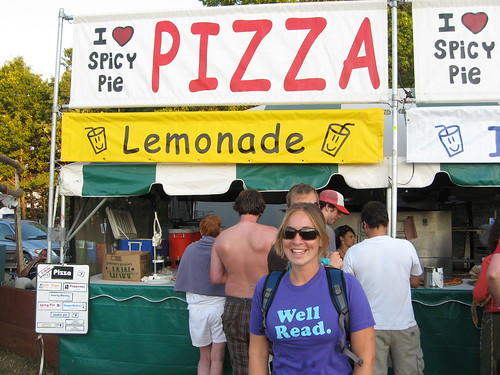
Anna Whalen lovin' the pie.
But still, I was hoping for more. After all, we were promised Michigan's largest organic Farmers' Market! And while there was, it's true, a farmers' market, it was tucked off in an out of the way corner, behind the ecovillage and well off the beaten path. Some of the farmers seemed a little non-plussed by their location. After talking to Madison House staff, it seems that two factors contributed to the situation. First, they had to reconfigure the main gates after heavy rains the day before the show opened, and this left the market out of the original flow of traffic. Second, this was the first festival experience for most of the farmers, who didn't want to stay later than perhaps 11:30 PM. This meant that they had to group the farmers' booths in a place where it wouldn't look like the festival was closing up shop early--no one wants to walk by a bunch of tarped up booths during a 24-hour party.
The real disappointment was that the farmers brought stuff that might make sense at a normal farmers' market--things like loaves of fresh bread, quarts of fresh strawberries, and blocks of cheese. But they were located INSIDE the festival grounds, not in the campgrounds. What on earth is a person about to spend six or eight hours bouncing around from Thievery Corporation to Michael Franti to Primus to Dave Matthews (I know, they didn't play in that order) supposed to do with a quart of strawberries or some raw milk cheese that needs immediate refrigeration? I was begging for a really delicious sandwich made from fresh local ingredients, but all I got were instructions to buy a loaf of bread, a round of cheese, and some meat and make my own sandwich. Not exactly what I had in mind.
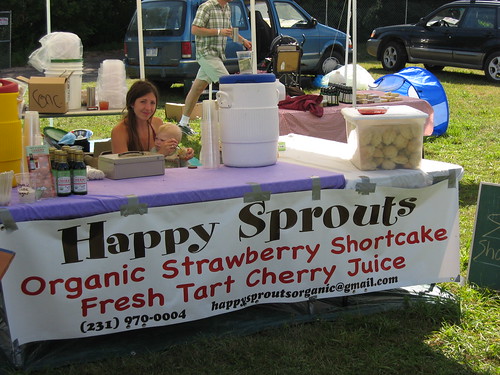
About the only portable food at the farmers' market.
In the general store, which I had been assured would have all of my camping needs and plenty more at prices below that of Whole Foods, I found dozens of loaves of fresh, locally made "English Muffin Bread" for $5 each, along with (glass) jars of jam from a local purveyor, also for $5. Unfortunately, the bread was all marked "best when toasted," and I'm guessing that even in RV-Land, there weren't many toasters to be found here. Otherwise, prices were a bit higher than I'd been promised--$2 for an apple or banana on the first day (later marked down to $1), $3 for a bag of ice, and so on. But they weren't too far out of line, and they also had locals in the general store serving what looked like really good coffee to appreciative caffeine-freaks.
So what went right and what went wrong? Well, we didn't starve, and they never ran out of spicy pie. But I had hoped for much better integration of the farmers' market, and slightly lower prices in the general store. Chalk it up to inexperience on the part of the farmers and first-year jitters. Hopefully, next year farmers will get the message that they should have portable food, like sandwiches, ready for our consumption and be ready to stay late or partner with other vendors who are already planning on all-night service. Another option might be to move the market out to the campgrounds and integrate it into the general store. All in all, a great idea that I hope to see again, but one that needs a bit more polish to be fully functional.
Education
One of the most important things a festival like this can do is introduce green concepts to the masses. Demystifying green issues like composting or solar power can go a long way to fostering change in the public at large. Unfortunately, most festivals have relegated their green efforts to poorly done "green villages" filled with leftover hippies and other sixties burnouts selling patchouli and handing out photocopied fliers railing against the evils of cell phones. Maybe you make a tour through the green area, sign a petition, get preached to a bit, and move on to have some fun, but that's about the extent of it.
Rothbury, on the other hand, took its educational opportunities to heart. Sure there was something of an ecovillage, with info on solar panels, a biodiesel powered school bus, and a bookstore run by the most excellent Better World Books selling books on climate change. But there was nary a hippie to be seen in the ecovillage, and hip organizations like RVL7 selling some pretty fashionable t-shirts kept people engaged. As far as ecovillages go, it wasn't bad.
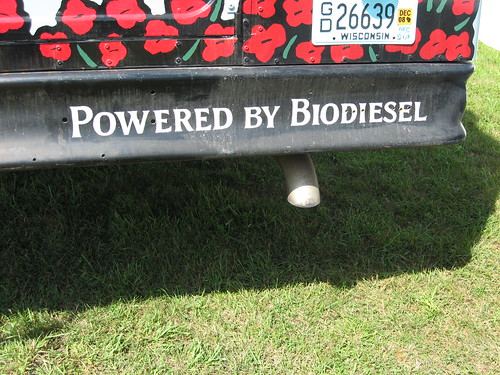
But my problem with ecovillages -- even good ones like this -- is that they marginalize the green movement. If we're going to get this whole sustainability thing down, we're going to need a lot more integration into the mainstream. And that's where Rothbury really ramped things up. After all, it billed itself as a "party with a purpose." It's not like fans didn't arrive knowing they were going to be expected to think about sustainability for at least a few minutes. And Rothbury did a good job of trying to expand the boundaries of what a fun weekend could be with lots of intimate Think Tank sessions. These sessions, curated by Dr. Steven Schneider, one of the IPCC Nobel laureates, covered a really broad array of topics and all involved at least one of the musicians performing at the festival. It was somewhat incongruous to see Hunter Lovins of Natural Capitalism fame sharing a stage with Ken Jordan from the Crystal Method, but it somehow worked. All of the seats at the event I attended were full, and the audience seemed interested and was asking some good questions when I ran off to get to my next show.
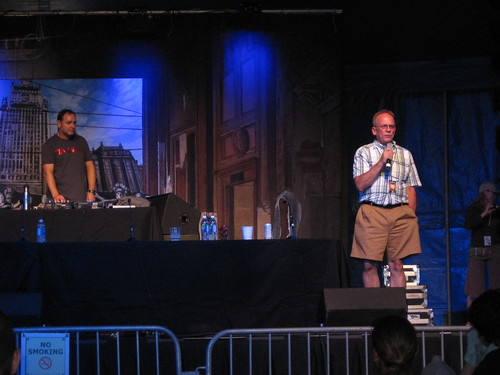
Award-winning journalist Bud Ward and Ken Jordan of the Crystal Method
But that was the problem--as interesting as the Think Tank sessions looked, they were up against some top quality music, music that people had paid hundreds of dollars and travelled thousands of miles to see. Even a dedicated greenie like me could only find time to attend two of the events during the weekend, partly because the sheer size of the festival grounds made it impractical to keep bouncing back to the venue at the main gate where many of the Think Tank events were held. So as sincere as the effort was, I'm not sure how much difference it made. Still, kudos to the organizers for going with a risky idea--lectures at a music festival? -- and for getting some really top-notch names to participate.
One area that seemed more successful was in artist education. All of the Think Tank sets had at least one musician, which speaks to the level of commitment that many of these performers on the festival circuit have for the environment. And in my conversations with artists backstage, every single one of them was happy to be part of a festival that was promoting a good social cause. I could see the lightbulbs going off for some artists when I was asking them about greening their tours, while other artists seemed really relieved that a festival organizer was finally getting to their level of thinking on these issues. At the end of the day, artists will have far more sway with the general public than organizers at a festival, so it was really heartening to see such a positive response to the message from the performers.
What went right? The overall mainstreaming of the message was a definite success. Artists and fans both seemed to get into the green theme, and Think Tank sessions seemed well attended despite some ferocious competition. Again, I can't say that anything went wrong, but in future years I'd like to see the Think Tanks placed in a more central location and/or scheduled earlier than the music so that we don't have to make such tough choices. I'd also like to see the ecovillage concept, like the farmers' market it shared a space with, moved to a more visible area.
Public Art
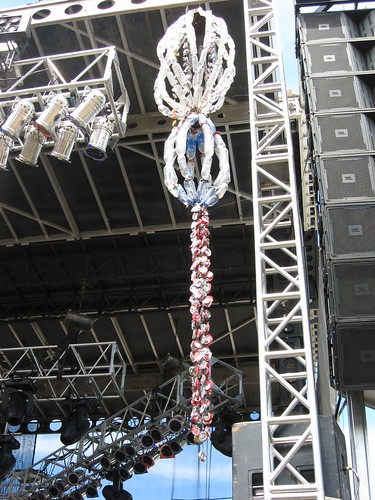
Um, yeah.
I'll keep this one short, since I know least about it. We were told that all of the art was made of reclaimed or otherwise green materials, and my observations seemed to bear this out. But what was more refreshing was that there was a pretty significant amount of public art in the first place. Some of it, like the giant chandelier-like effects made of plastic water bottles and cans at the Sherwood Court stage, didn't quite work. But on the other hand, the piece de resistance for the entire festival was without a doubt Sherwood Forest, a truly magical place covered in lights, hammocks, a secret stage, with lots of paths to draw you in and places to get lost (but not too lost!). Sherwood Forest, more than any one performance, was the highlight of the festival for me, and I suspect for many others, too. Kudos to the artists who put it together, and I hope that you're able to do something even more exciting with the space next year!
The forest was most impressive at night, but it was also very difficult to photograph. This rather jittery YouTube clip does it a bit of justice, though. Still, you absolutely had to be there. I'm told by my Burning Man friends that this was as close to that event as anything they'd been to.
What went right? Sherwood Forest! What went wrong? Really, nothing--I can't wait to see what they dream up next year!
Community Relations
Big festivals like Rothbury and Bonnaroo have to make sincere and significant efforts to make friends in their host communities from the very beginning or risk being banished. Done right, it can be a real win-win. Done wrong, it can end up with the festival not happening at all--does anyone really think Vineland still has a chance now that the neighbors have formed an alliance dedicated to stopping it?
Rothbury took its green message to the village of Rothbury in some significant ways. The most visible was the donation of $50,000 of solar panels to a nearby school. The panels, put up by Black Rock Solar of Burning Man fame in collaboration with a Michigan-based solar installer, will be augmented by more panels funded by the voluntary $4 donations that thousands of fans chipped in. And Rothbury went to great lengths to make sure that the money that would have gone to paying the electric bill stays in the school to make life better for the students.
The festival also bent over backwards to find local sources for as much as possible, including a local biodiesel company that produced the fuel from local waste animal products, the farmers in the farmers' market, and even semi-local artists like Betty Lavette, who gave one of the most inspired performances of the weekend.
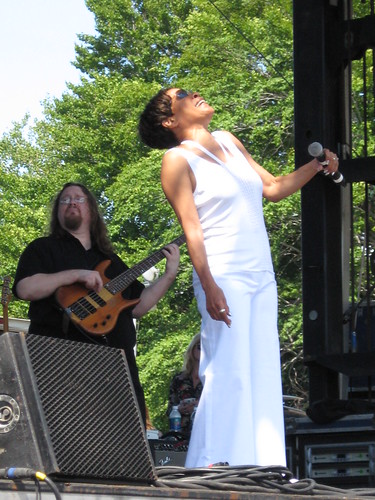
Betty Lavette belting it out.
Beyond that, the festival worked with Conscious Alliance on a food drive and organized a new world-record for the largest canned food sculpture ever, with more than 50,000 cans in the shape of one hand giving a can to another. I heard through the grapevine that the food drive was the most successful ever for the group, with more than 40 bins of food collected the first day alone. All of the food collected went to local food banks.
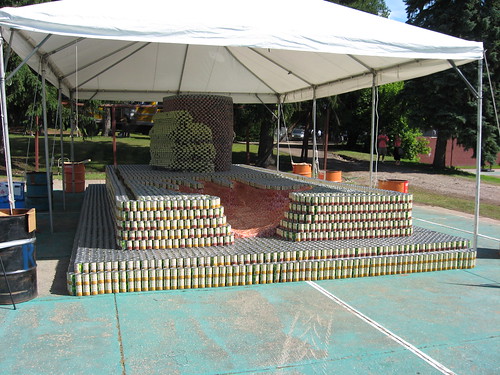
This is what 50,000 cans of beans look like.
Finally, as I mentioned above, the festival worked diligently to keep useful goods left behind by patrons out of the landfill, setting up a "free yardsale" for local charities to reuse the myriad of shoes, chairs, and tents left behind.
Wrap up
All-in-all, it was a fantastic weekend. The music was perfect, the vibe was uber-relaxed and friendly, and people really seemed into the idea of a socially conscious festival. Aside from a few very minor quibbles, everything went flawlessly, and all I can say is that I can't wait to go back next year!
Rothbury's attendance came out at somewhere around 35,000-40,000, roughly the same size as Burlington, VT, so it's not a stretch when I say that this really is a temporary city. And just like any other city, festival organizers have to deal with real city issues: waste management, providing clean drinking water and decent sanitation services, community relations with neighboring municipalities, transportation issues, and so on. At Rothbury, they also took on the decidedly city-like tasks of education and public art. We'll cover each of these issues one-by-one in this post. Ready? Let's go!
Transportation: Getting There
One of the problems of a camping festival is that it's pretty hard to find a site that's easily accessible on any kind of decent public transportation. By and large, people drive to these things, with the exception of us uber-polluters who really burn some carbon and fly there. I flew in, feeling vaguely guilty about my vastly inflated carbon footprint, but at least I was able to catch the shuttle offered by Mr. Busdriver and come in car-free.
Mr. Busdriver is a relatively new service, run by a frenetic but cheerful madman named Rick. He's going after the festival market in a big way by organizing bus transportation to and from these festivals. I got to meet him at the festival and he's an all around good guy, but he seemed frighteningly disorganized at times. I think all 7 of us on the special van he chartered to pick up the stragglers at the airport got 4 or 5 phone calls and emails from him in the days before the festival and on our arrival day itself. But he managed to keep it all together and after a 90-minute wait at the airport we got in our van. The driver he hired was good enough to stop at a local grocery store so we could buy some essentials before we got sequestered into the land of expensive festival general stores, so I was able to load up on PBR and cheap gin. In comparison to the nightmarish ride I had in to Langerado, this was pure luxury. I just hope that next time around, he's a little bit more organized.
Our ride in was fast and traffic-free, and as promised we ended up at a special back entrance close to the main gate. Things briefly fell apart there, though. By now it was 9:30, a full 4.5 hours after I'd arrived at the airport 75 miles away, and all of us were anxious to get into the festival. But for some reason, security wouldn't let us in, so we had to cool our heels in the parking lot of a nearby school while Rick frantically negotiated with the guards. Eventually, a compromise was reached, and we were allowed to walk through the gates. This meant unloading all of our bags and groceries, walking through security, and loading our gear back up into a separate van on the other side of the gates for a brief ride to car-free camping.
Once there, we were informed that we would need to be on a 7AM shuttle bus on the way out Monday morning, even though most of us had afternoon flights. Apparently, the 10AM bus had sold out, but at this point we all just wanted to get in. Car-free camping turned out to be great, a beautiful lawn just a 3-minute walk from the main gate and near the general store and merch tents, with a lightly-used (hence always clean) bank of well-lit portapotties right next to us and showers and water station a few minutes beyond.
It's worth mentioning that the organizers planted grass on hundreds of acres of camping areas and on the festival grounds themselves to make things more comfortable for us, and it's a good thing, too. Before we arrived, there were several inches of rain, but there were only a couple of muddy spots. Compared to Phish's IT and Coventry festivals and Bonnaroo 2004, all muddy disasters, this was a fantastic experience.
Of the people I talked to who drove in, not one had any complaints of significant traffic jams on the way in. That's not just a fan-pleaser, but an environmentally good thing. Having thousands of fans sit in traffic for 6 or more hours, as seems to be the case at most festivals, is a huge waste of fuel and a terrible thing for local air quality, never mind the CO2.
Speaking of CO2, the festival offered fans the chance to offset their CO2 in transit for a paltry $3 via the Bonneville Environmental Foundation, with an upgrade to a $7 package that also supported a very large solar project on the school where we cooled our heels. A nice touch was that we could buy these offsets on site if we didn't do it when we purchased tickets. Since my ticket was comped by the festival, this gave me a way to offset my own travel. Organizers reported that about 20% of the fans chose to offset, a huge number in the world of offsets, and the vast majority of those contributed to the school's solar panels.
So what went right and what went wrong with transportation? Well, the lack of traffic jams was a huge plus, although I'm not sure whether to credit this to the size of the crowd or the organizers. The push for offsets and the ease of buying them was also a good thing. Organizers went to great lengths to get people out of their cars and promote carpooling, offering incentives like the fantastic car-free camping and options like Mr. Busdriver. On the down side, the interface between Mr. Busdriver and the festival was poorly done. It's to the festival's benefit to get more people to come in by bus, so they need to better integrate ordering bus tickets into the Rothbury website, work with Rick to set up a schedule of bus service that makes sense and help him fill as many buses as possible, and most importantly make sure that nothing like our horrible welcome by security ever happens again.
The festival also needs to pick one carpooling partner and funnel all the ridesharing to that central location. Pickuppal.com is making a play to be the music-related rideshare organization of choice, but when I spoke with management there, they told me that Rothbury had declined an offer to go exclusive with them because of perceived liability issues. Pickuppal is the official rideshare partner of both Dave Matthews and John Mayer, so it would have made sense to use the service for Rothbury instead of directing us to no fewer than 10 rideshare sites, ensuring that no one site got a critical mass going.
To finish on a more positive note, the festival did a good job of partnering with Amtrak and the local ferry services, and it would be really wonderful to see them expand and better promote these in future years. With some sources predicting $7 a gallon gas by next summer, anything Rothbury can do to help customers get to the site will be sure to pay back with increased attendance.
Waste Management
Rothbury really shined when it came to taking out the trash, mostly by doing everything they could to make sure there wasn't nearly as much trash in the first place. A crew of more than 500 volunteers manned hundreds of waste stations, each with three different-colored bins for compost, recyclables, and landfill.

A volunteer hard at work manning the waste stations.
The volunteers were there to make sure that patrons knew which bins to use for things that might not normally be associated with compost. Every vendor was required to purchase compostable cups made from corn, compostable plates made from wheat, and compostable silverware made from rice. All of the beer was either draft or served in aluminum bottles (and by the way, having a couple of non-Bud options was a well-received plus). There were at least 3 or 4 sources of free water in the grounds and patrons were encouraged to bring refillable water bottles. Those of us who chose to purchase $3 bottles of water were served Earth Water, which gives 100% of profits to the UN Refugee Agency to provide clean drinking water to the developing world. And outside of food and beverage items, what is there really to dispose of inside the festival gates?

As the picture above indicates, the volunteers manning the bins looked pretty bored most of the time because organizers made sure from the get-go that everyone knew the deal. The back of the folded festival guide/map, which was itself far smaller than the books given out at other festivals and presumably printed on postconsumer recycled paper, was entirely devoted to a simple graph detailing what belonged in each bin, and once people had been gently instructed by the first volunteer what they should do, they pretty much got it.

All this attention to managing waste paid off, as Sarah gleefully announced a diversion rate of more than 80% at a press conference dedicated to the green aspects of the festival. When we visited the waste collection area the next day, this was down slightly to 73%. Sarah explained that as they moved between waste collection in the campgrounds and the festival grounds, the figure fluctuated but that they were hoping to end up with over 80% of the waste diverted. Speaking of campground waste, the festival collected all of the discarded tents, coolers, shoes, and anything else of value and donated them to local charities instead of tossing them.
While the volunteers manning the waste stations were happily underworked, the volunteers behind the scenes at the waste station couldn't make any such claims. When a small army of journalists showed up in golf carts to check out composting in action, we found about 10 very industrious volunteers laboriously sorting the contents of every bag of trash, recycling, and compost to make sure that everything ended up in the right pile. The workers seemed to be in high spirits, with Phish blaring from a boombox and once-per-shift cash prizes given to the lucky winner who found the most unusual or humorous piece of refuse. One thing that surprised me was that the compost pile didn't smell nearly as bad as I expected it would, although it certainly wouldn't have passed for perfume. Unfortunately, we were too early to see the giant grinder Sarah had commissioned to mulch the compost arrive to perform its work.

Sarah Haynes in front of the compost pile, holding a bottle of Earth water.

Even the bags that held the compost are biodegradable!
Perhaps the best part about all of this was that the festival grounds were always spotless after fans left. People really seemed to get into the spirit, and there were far fewer discarded water bottles and cups than I've come to expect at the end of most sets. I even had a volunteer walk up to me while I was chatting with one of the festival artists after a set and relieve me of a beer cup I'd been planning to compost later. The crew at Madison House told me that they needed far fewer people to clean up after each set than at other festivals--as few as 7 in one instance, compared to perhaps 150 at a similar event elsewhere. And it showed--in the picture below, you won't see anything at all, not a cup or bottle or even a bottle cap. The organizers even handed out matchbox-sized personal ashtrays, which while certainly not 100% effective might have helped a bit.

Not a speck of trash!
So what went right and what went wrong? This is an easy one--waste collection and diversion was the festival's most visible and obvious success. The only hiccup I found was that we weren't given either trash bags or recycling bags when we entered the festival, although that might have been related to the whole snafu when we entered the festival.
Water and Sanitation
One of the things that can make or break a festival is adequate drinking water and decent restroom facilities. The water stations at this year's Langerado were abysmal on the one occasion when I could actually find water, and the toilets at the 2004 Bonnaroo were among the most disgusting things I've ever witnessed in a long and depraved career, Fear Factor times 10 (the toilets at last year's Bonnaroo were much improved).
So I was very pleased to see that the water stations in the campgrounds seemed to be well laid out. They used the shipping container approach that Bonnaroo pioneered, with trough sinks and a floor to keep you out of the mud, and all the water going to a big frac tank. Showers, reportedly sometimes hot, could be had for $10 with very short lines, and there were a smattering of free water stations inside the festival gates.
The restrooms, standard plastic portolets, were in general as clean as I've seen them at any festival, although we were a bit spoiled by our underused car-free camping restrooms. Some of the restrooms even had mirrors and a shelf for your beer! I can't recall waiting more than one minute for a restroom at any point during the weekend, and by and large the restrooms were located under a light source, one of those simple but often-overlooked touches that really helps keep the filth quotient down.
All in all, the festival did a nice job with these essentials. What went right? Good water services in the campgrounds, free water refills in the festival, and clean and numerous toilets. I can't say anything went wrong, but I'd really like to see the festival break new ground in the US festival scene and push for some really nice composting toilets. I'd also like to see a sink of some sort outside some of the larger banks of restrooms for handwashing, or at least a tub of antibacterial gel. I'd also like to see a few more drinking water stations scattered around the festival grounds.
Feeding the Masses
What would a festival be without Spicy Pie? The food here was more of the same--$10 burritos, $5 slices, and so on, but I can't really complain. It was hot and fresh and to be honest, I really do love Spicy Pie.

Anna Whalen lovin' the pie.
But still, I was hoping for more. After all, we were promised Michigan's largest organic Farmers' Market! And while there was, it's true, a farmers' market, it was tucked off in an out of the way corner, behind the ecovillage and well off the beaten path. Some of the farmers seemed a little non-plussed by their location. After talking to Madison House staff, it seems that two factors contributed to the situation. First, they had to reconfigure the main gates after heavy rains the day before the show opened, and this left the market out of the original flow of traffic. Second, this was the first festival experience for most of the farmers, who didn't want to stay later than perhaps 11:30 PM. This meant that they had to group the farmers' booths in a place where it wouldn't look like the festival was closing up shop early--no one wants to walk by a bunch of tarped up booths during a 24-hour party.
The real disappointment was that the farmers brought stuff that might make sense at a normal farmers' market--things like loaves of fresh bread, quarts of fresh strawberries, and blocks of cheese. But they were located INSIDE the festival grounds, not in the campgrounds. What on earth is a person about to spend six or eight hours bouncing around from Thievery Corporation to Michael Franti to Primus to Dave Matthews (I know, they didn't play in that order) supposed to do with a quart of strawberries or some raw milk cheese that needs immediate refrigeration? I was begging for a really delicious sandwich made from fresh local ingredients, but all I got were instructions to buy a loaf of bread, a round of cheese, and some meat and make my own sandwich. Not exactly what I had in mind.

About the only portable food at the farmers' market.
In the general store, which I had been assured would have all of my camping needs and plenty more at prices below that of Whole Foods, I found dozens of loaves of fresh, locally made "English Muffin Bread" for $5 each, along with (glass) jars of jam from a local purveyor, also for $5. Unfortunately, the bread was all marked "best when toasted," and I'm guessing that even in RV-Land, there weren't many toasters to be found here. Otherwise, prices were a bit higher than I'd been promised--$2 for an apple or banana on the first day (later marked down to $1), $3 for a bag of ice, and so on. But they weren't too far out of line, and they also had locals in the general store serving what looked like really good coffee to appreciative caffeine-freaks.
So what went right and what went wrong? Well, we didn't starve, and they never ran out of spicy pie. But I had hoped for much better integration of the farmers' market, and slightly lower prices in the general store. Chalk it up to inexperience on the part of the farmers and first-year jitters. Hopefully, next year farmers will get the message that they should have portable food, like sandwiches, ready for our consumption and be ready to stay late or partner with other vendors who are already planning on all-night service. Another option might be to move the market out to the campgrounds and integrate it into the general store. All in all, a great idea that I hope to see again, but one that needs a bit more polish to be fully functional.
Education
One of the most important things a festival like this can do is introduce green concepts to the masses. Demystifying green issues like composting or solar power can go a long way to fostering change in the public at large. Unfortunately, most festivals have relegated their green efforts to poorly done "green villages" filled with leftover hippies and other sixties burnouts selling patchouli and handing out photocopied fliers railing against the evils of cell phones. Maybe you make a tour through the green area, sign a petition, get preached to a bit, and move on to have some fun, but that's about the extent of it.
Rothbury, on the other hand, took its educational opportunities to heart. Sure there was something of an ecovillage, with info on solar panels, a biodiesel powered school bus, and a bookstore run by the most excellent Better World Books selling books on climate change. But there was nary a hippie to be seen in the ecovillage, and hip organizations like RVL7 selling some pretty fashionable t-shirts kept people engaged. As far as ecovillages go, it wasn't bad.

But my problem with ecovillages -- even good ones like this -- is that they marginalize the green movement. If we're going to get this whole sustainability thing down, we're going to need a lot more integration into the mainstream. And that's where Rothbury really ramped things up. After all, it billed itself as a "party with a purpose." It's not like fans didn't arrive knowing they were going to be expected to think about sustainability for at least a few minutes. And Rothbury did a good job of trying to expand the boundaries of what a fun weekend could be with lots of intimate Think Tank sessions. These sessions, curated by Dr. Steven Schneider, one of the IPCC Nobel laureates, covered a really broad array of topics and all involved at least one of the musicians performing at the festival. It was somewhat incongruous to see Hunter Lovins of Natural Capitalism fame sharing a stage with Ken Jordan from the Crystal Method, but it somehow worked. All of the seats at the event I attended were full, and the audience seemed interested and was asking some good questions when I ran off to get to my next show.

Award-winning journalist Bud Ward and Ken Jordan of the Crystal Method
But that was the problem--as interesting as the Think Tank sessions looked, they were up against some top quality music, music that people had paid hundreds of dollars and travelled thousands of miles to see. Even a dedicated greenie like me could only find time to attend two of the events during the weekend, partly because the sheer size of the festival grounds made it impractical to keep bouncing back to the venue at the main gate where many of the Think Tank events were held. So as sincere as the effort was, I'm not sure how much difference it made. Still, kudos to the organizers for going with a risky idea--lectures at a music festival? -- and for getting some really top-notch names to participate.
One area that seemed more successful was in artist education. All of the Think Tank sets had at least one musician, which speaks to the level of commitment that many of these performers on the festival circuit have for the environment. And in my conversations with artists backstage, every single one of them was happy to be part of a festival that was promoting a good social cause. I could see the lightbulbs going off for some artists when I was asking them about greening their tours, while other artists seemed really relieved that a festival organizer was finally getting to their level of thinking on these issues. At the end of the day, artists will have far more sway with the general public than organizers at a festival, so it was really heartening to see such a positive response to the message from the performers.
What went right? The overall mainstreaming of the message was a definite success. Artists and fans both seemed to get into the green theme, and Think Tank sessions seemed well attended despite some ferocious competition. Again, I can't say that anything went wrong, but in future years I'd like to see the Think Tanks placed in a more central location and/or scheduled earlier than the music so that we don't have to make such tough choices. I'd also like to see the ecovillage concept, like the farmers' market it shared a space with, moved to a more visible area.
Public Art

Um, yeah.
I'll keep this one short, since I know least about it. We were told that all of the art was made of reclaimed or otherwise green materials, and my observations seemed to bear this out. But what was more refreshing was that there was a pretty significant amount of public art in the first place. Some of it, like the giant chandelier-like effects made of plastic water bottles and cans at the Sherwood Court stage, didn't quite work. But on the other hand, the piece de resistance for the entire festival was without a doubt Sherwood Forest, a truly magical place covered in lights, hammocks, a secret stage, with lots of paths to draw you in and places to get lost (but not too lost!). Sherwood Forest, more than any one performance, was the highlight of the festival for me, and I suspect for many others, too. Kudos to the artists who put it together, and I hope that you're able to do something even more exciting with the space next year!
The forest was most impressive at night, but it was also very difficult to photograph. This rather jittery YouTube clip does it a bit of justice, though. Still, you absolutely had to be there. I'm told by my Burning Man friends that this was as close to that event as anything they'd been to.
What went right? Sherwood Forest! What went wrong? Really, nothing--I can't wait to see what they dream up next year!
Community Relations
Big festivals like Rothbury and Bonnaroo have to make sincere and significant efforts to make friends in their host communities from the very beginning or risk being banished. Done right, it can be a real win-win. Done wrong, it can end up with the festival not happening at all--does anyone really think Vineland still has a chance now that the neighbors have formed an alliance dedicated to stopping it?
Rothbury took its green message to the village of Rothbury in some significant ways. The most visible was the donation of $50,000 of solar panels to a nearby school. The panels, put up by Black Rock Solar of Burning Man fame in collaboration with a Michigan-based solar installer, will be augmented by more panels funded by the voluntary $4 donations that thousands of fans chipped in. And Rothbury went to great lengths to make sure that the money that would have gone to paying the electric bill stays in the school to make life better for the students.
The festival also bent over backwards to find local sources for as much as possible, including a local biodiesel company that produced the fuel from local waste animal products, the farmers in the farmers' market, and even semi-local artists like Betty Lavette, who gave one of the most inspired performances of the weekend.

Betty Lavette belting it out.
Beyond that, the festival worked with Conscious Alliance on a food drive and organized a new world-record for the largest canned food sculpture ever, with more than 50,000 cans in the shape of one hand giving a can to another. I heard through the grapevine that the food drive was the most successful ever for the group, with more than 40 bins of food collected the first day alone. All of the food collected went to local food banks.

This is what 50,000 cans of beans look like.
Finally, as I mentioned above, the festival worked diligently to keep useful goods left behind by patrons out of the landfill, setting up a "free yardsale" for local charities to reuse the myriad of shoes, chairs, and tents left behind.
Wrap up
All-in-all, it was a fantastic weekend. The music was perfect, the vibe was uber-relaxed and friendly, and people really seemed into the idea of a socially conscious festival. Aside from a few very minor quibbles, everything went flawlessly, and all I can say is that I can't wait to go back next year!